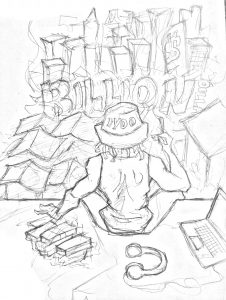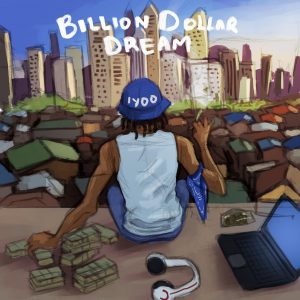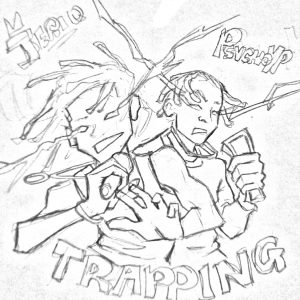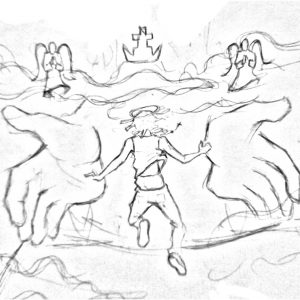NCVRD: How Nonso Nwangwu Created Jeriq’s ‘Billion Dollar Dream’
"I could relate to his struggles, so I just found it very easy to create this idea."
"I could relate to his struggles, so I just found it very easy to create this idea."
“I’ve been drawing since I was about 6 or 7 years old,” Nonso Nwangwu tells me over a zoom call on an early June evening. From childhood, art has been a big part of Nonso’s life, sometimes taking priority space, other times lurking around as he explored other interests like chasing the dream to become a professional soccer player. These days, along with his love for music and passion for storytelling, he’s doing the art on a respectable level, with his latest marquee work being the cover art for ‘Billion Dollar Dream’, the well-received debut LP from Nigerian rap artist Jeriq.
View this post on Instagram
In the last few years, the Enugu native rapper has grown from underground rap artist to cult hero to national recognition. His music, centred on a searing grind mentality, has earned him reputation as a hustler’s rapper, mixing declarative lines of personal ambitions with vivid details from his life, resulting in motivational vignettes that are deeply relatable. Rapping in a predominant mix of Igbo and pidgin English, mostly over minimalist Trap beats, Jeriq is the latest rising star from indigenous rap music, and ‘Billion Dollar Dream’ is the latest lodestar in the quest to satisfy his unquantifiable ambition.
A Jeriq fan, Nonso has always been able to relate to the stories, struggles and hustle motif the rapper embeds in his music. That ability to identify with the artist’s core message played a huge role in his work on the cover art. The illustration seems simple but the weighty message behind each element on the cover is what makes this piece of art standout. The creator also managed to tie his personal experiences into this art. “The best thing about working with Jeriq was the creative freedom,” he tells.
Being born and raised in the Eastern part of Nigeria just as Jeriq, stories which were told on most of the records, such as “True Life Story,” were easy for Nonso to personalise and convert into visual assets. As the creator of the artwork, it’s only fair that Nonso remembers every element on the cover but his ability to remember each element vividly without looking through the art stood out to me the most.
Creating the cover art for ‘Billion Dollar Dream’ has become one of the most thrilling projects the digital artist has worked on till date as he has worked majorly with artists still on the rise. According to Nonso, Jeriq’s mentality has elevated from the hood where he started from and for that reason, he’s seated on a high rise building, looking over the entire neighbourhood and looking directly at the bigger buildings, now focusing on the bigger picture.

Our conversation with Nonso Nwangwu follows below, and has been lightly edited for clarity.
NATIVE: Could you brief me on your background, where are you from and what led you to visual and graphic design?
Nonso: I was born and raised in Owerri, Imo state. I’ve always been drawing since I was very little. I’ve been drawing since I was about 6 or 7 years old if I remember correctly but I started digital painting in my first year of university in University of Nigeria, Nsukka in 2017. I was always a huge fan of art but I wasn’t drawing anymore after a while, I just left it and focused on other things like playing soccer and trying to go pro, but this was between my final year in secondary school and when I got admission into university. It wasn’t until a friend showed me a sketch app on his phone one day in church in late 2017 that I decided to pick up the skill again and see what I could do with it.
NATIVE: What are your earliest memories of pursuing your current career path?
Nonso: I had tried painting in the sketch app before but I couldn’t get into it, it was too hard for me to work with so I honestly just didn’t bother like I said and this was in 2015. So I wouldn’t really say that I gave it a proper chance until 2 years later.
NATIVE: So when would you say you professionally started making your own designs?
Nonso: Professionally, mid 2018. I had spent between early 2018 and mid 2018 learning on my phone then.
NATIVE: Had you created for anyone before Jeriq?
Nonso: Yes, I’ve created designs for a lot of people but off the top of my head right now, I can’t really remember anyone but they’re mostly upcoming artists. I also just did something recently for Lil Kesh and although it came out after Jeriq’s, I had worked on it before I rounded up Jeriq’s project.
NATIVE: So let’s talk about Jeriq’s cover art for ‘Billion Dollar Dream’. What was the scope of the work you did for Jeriq’s album art direction?
Nonso: Ok, so someone on Jeriq’s team reached out to me and commended my work and asked if I was interested in working on the art direction for the entire project and I’ve always been a huge Jeriq fan since early last year so we started talking and they mentioned the name of the album was going to be ‘Billion Dollar Dream’ and his first project was titled ‘Hood Boy Dreams’ so when I put those together, the first thing that came to mind was fixing Jeriq in a light where he had elevated, that’s why you see him sitting where he is. Yes, he’s still a hood boy but his mind has left the hood so that was the initial idea I had and that was what I then created from.

NATIVE: Did you work on this alone or will you say Jeriq had a large input? How collaborative was the process between you two?
Nonso: For the album cover itself, it was basically just me. I heard the album title, I had an idea and I just sent him a sketch which he instantly loved so there was no back and forth at all. We worked on 10 covers together, each song has a distinct cover so there was more collaboration on the individual covers but for the album, I sent him a rough sketch and he loved it so I just developed that further.
NATIVE: When you heard this project, what were your first thoughts about the music and how did that translate into the art that you made?
Nonso: To be very honest, it was easy for me to translate his music into art. I had to go to Enugu to link up with him, listen to the project and then create something but I was already familiar with Jeriq’s music so translating that into art was not difficult. I would say I’m a hood boy myself so I could relate to his struggles, trying to get money, trying to hustle to leave the hood, so I could understand Jeriq and I just found it very easy to create this idea from everything I had listened to.
NATIVE: Can you run me through what the cover means from your own perspective?
Nonso: Dreams. We all have our dreams, somewhere we’re all trying to get to. Never stop, just keep going, no matter how hard it gets, just keep fighting for what you want
NATIVE: Can you also talk me through the elements on the cover art from the bag of weed to the neighbourhood?
Nonso: Everything represents Jeriq in one way or the other. Jeriq smokes a lot so the bag of weed and the backwoods had to be represented there. From where he’s sitting, he can see the entire area which is his hood and right now, his mentality has matured and he’s no longer thinking like he’s in the hood, even if he still is. Now, he’s seated on a tall building still in the hood but looking at more taller buildings just in front of him, he’s now focused on doing bigger things and becoming even more successful. Jeriq is also on his laptop, he makes music from there so that also has to be represented along with his headphones which he always has with him and then there’s money, well he’s a rich man so why not. Also his brand “Iyoo Cartel” is represented on his bucket hat.

NATIVE: How long did this take you to create the art?
Nonso: It took about a week to have the cover art sorted out but there was more back and forth on the individual covers.
NATIVE: Which individual cover did you enjoy working on the most?
Nonso: “True Life Story”, “Chukwuebuka” and “Trapping”
NATIVE: Why those three?
Nonso: I love the story “True Life Story” tells about secondary school, teachers being wicked and basically understanding life and I could relate to that so being about to work on that art was very inspiring then with “Trapping”, i love the colours and the concept so much and with “Chukwuebuka”, I’m a christian and I love praying so translating that into art was also very interesting for me
NATIVE: What’s the best thing about working with Jeriq?
Nonso: Creative freedom. Jeriq has no stress at all, and he trusted me enough to allow me handle this project.
NATIVE: Will you say you were able to tell Jeriq’s story with this art?
Nonso: Yes, 100 percent. I believe Jeriq was satisfied with my work.

Featured Image Credits/NATIVE

